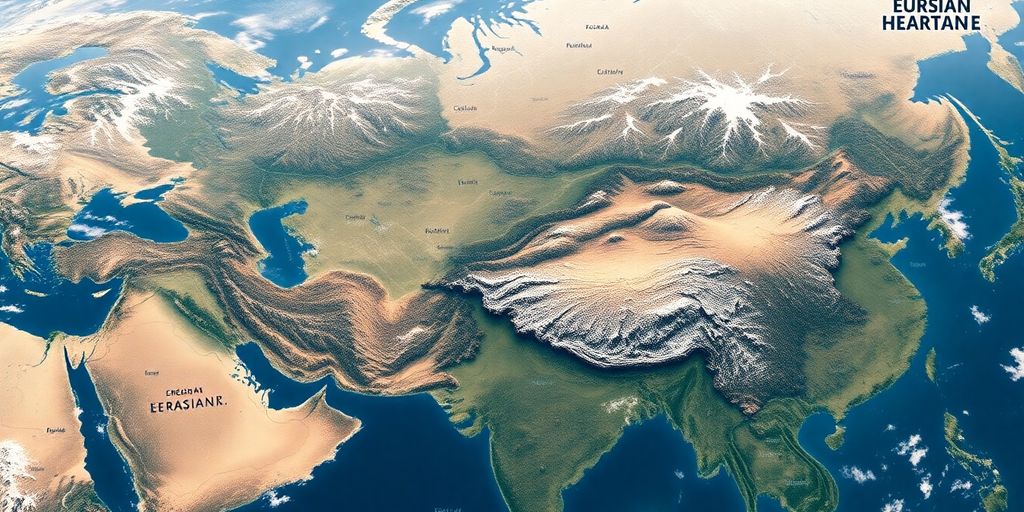The Geographical Pivot of History and Heartland Theory: Understanding Global Power Dynamics

The Geographical Pivot of History, a concept introduced by Halford Mackinder, highlights how geography can shape the course of world events. Mackinder argued that the Heartland, a central area in Eurasia, holds the key to global power due to its resources and strategic location. This article will explore the origins of the Heartland Theory, its key concepts, its relevance today, and the ongoing debates surrounding it. By understanding this theory, we can better grasp the dynamics of global power and the influence of geography on historical events.
Key Takeaways
- The Heartland is a crucial area for global power dynamics, as controlling it can lead to dominance over the world.
- Mackinder’s theory emphasizes the importance of geography in shaping political power and historical events.
- Technological advancements have changed the strategic significance of the Heartland in modern geopolitics.
- Critics argue that the Heartland Theory oversimplifies complex global interactions and is Eurocentric.
- The relevance of the Heartland Theory continues to be debated, especially in light of recent global developments.
The Origins of the Heartland Theory
Halford Mackinder’s Vision
Halford Mackinder, a British geographer, introduced the Heartland Theory in 1904. He believed that the control of the Heartland was crucial for global dominance. This theory emerged during a period marked by imperial rivalry, the expansion of industrial powers, and the development of global transportation networks.
Historical Context and Influences
Mackinder’s ideas were influenced by the geopolitical landscape of his time. The rise of empires and the competition for resources shaped his vision. He argued that the Heartland, located in the center of Eurasia, was vital due to its vast resources and strategic position. This area includes parts of Russia, Central Asia, and Eastern Europe, making it a key player in global politics.
Initial Reception and Criticism
Initially, Mackinder’s theory received mixed reactions. Some scholars praised its insights into global power dynamics, while others criticized it for being too simplistic. Critics argued that it overlooked the complexities of international relations and the impact of technological advancements. Despite the criticism, Mackinder’s theory laid the groundwork for future geopolitical discussions.
The Heartland Theory remains a significant concept in understanding how geography influences global power dynamics. It highlights the importance of location and resources in shaping international relations.
Summary
In summary, the Heartland Theory emerged from a unique historical context and has sparked ongoing debates about its relevance in modern geopolitics. Mackinder’s vision continues to influence how we think about power and strategy on a global scale.
Key Concepts of the Geographical Pivot of History
Defining the Heartland
The Heartland is a term coined by Halford Mackinder to describe a central area of Eurasia that holds significant geopolitical importance. This region includes parts of Eastern Europe and Central Asia, which Mackinder believed were crucial for controlling global power dynamics.
Strategic Importance of Central Asia
Central Asia is often viewed as a strategic hub due to its vast resources and location. Here are some key points about its importance:
- Resource Richness: Contains oil, gas, and minerals.
- Geopolitical Position: Acts as a bridge between Europe and Asia.
- Historical Conflicts: Has been the center of many historical power struggles.
Impact on Geopolitical Thought
Mackinder’s theory has influenced how nations view their geopolitical strategies. His ideas have led to:
- Increased focus on controlling the Heartland.
- Development of military strategies centered around this region.
- Ongoing debates about the relevance of geography in modern politics.
Mackinder’s work encourages us to think critically about how geography shapes our world and the power dynamics within it.
The Heartland Theory in the 20th Century
World Wars and the Heartland
During the two World Wars, the Heartland’s strategic importance became evident. Control over this region was seen as crucial for any power seeking to dominate Europe and Asia. The battles fought in and around the Heartland highlighted its role in global conflicts.
Cold War Strategies
In the Cold War, the Heartland was central to U.S. foreign policy. American leaders believed that the Soviet Union’s control of the Heartland posed a significant threat. This led to strategies aimed at containing Soviet influence, including the formation of NATO and various military alliances.
Adaptations and Critiques
Despite its influence, the Heartland Theory faced criticism. Critics pointed out that it oversimplified global politics by focusing too much on geography. Technological advancements, like air power and nuclear weapons, changed the dynamics of power, making the Heartland less significant than Mackinder originally suggested.
In summary, while the Heartland Theory shaped geopolitical strategies in the 20th century, it also faced challenges that questioned its relevance in a rapidly changing world.
Modern Interpretations and Relevance
21st Century Geopolitical Landscape
In today’s world, the Heartland Theory is still significant. It helps us understand how countries interact and compete for power. The rise of China and its focus on Central Asia shows that Mackinder’s ideas are still relevant.
Technological Advancements and Their Impact
Technology has changed how we view geography and power. Here are some key points:
- Air power and long-range missiles have changed military strategies.
- Cyber warfare has become a new battlefield.
- Global trade networks are more important than ever.
Current Geopolitical Theories
While Mackinder’s theory is important, other theories also play a role:
- Sea Power Theory: Emphasizes the importance of naval strength.
- World Systems Theory: Focuses on economic systems and global inequalities.
- Geoeconomics: Looks at how economic factors influence global politics.
The Heartland Theory remains a useful tool for understanding global power dynamics, especially as nations vie for control over strategic regions.
In conclusion, while the world has changed since Mackinder’s time, his ideas about the Heartland still provide valuable insights into modern geopolitics. Understanding these concepts can help us navigate the complexities of today’s international relations.
Criticism and Controversies

Debates Among Scholars
The Heartland Theory has sparked numerous debates among scholars. Many argue that it oversimplifies complex global dynamics by focusing too much on geography. Critics believe that other factors, like culture and technology, play a significant role in shaping power relations.
Ethical Implications
There are ethical concerns regarding the implications of the Heartland Theory. Some critics point out that it can promote a Eurocentric view of geopolitics, which may overlook the experiences of non-Western countries. This perspective can lead to biased foreign policies that favor certain regions over others.
Relevance in a Globalized World
In today’s interconnected world, the Heartland Theory faces challenges. The rise of global cooperation and interdependence makes the idea of a single dominant region less relevant. Here are some key points to consider:
- Technological advancements have changed how power is exercised globally.
- The importance of economic ties often outweighs geographical factors.
- New geopolitical theories are emerging that offer alternative views on global power dynamics.
The Heartland Theory, while influential, must be viewed critically in light of modern complexities and the evolving nature of global relations.
Overall, while the Heartland Theory has contributed to our understanding of geopolitics, it is essential to recognize its limitations and the need for a more nuanced approach to global power dynamics.
Case Studies in Global Power Dynamics
Russia’s Geopolitical Strategies
Russia has long viewed its position in the Heartland as crucial for its power. The Heartland’s strategic location allows Russia to influence neighboring regions. Key points include:
- Control over energy resources in Central Asia.
- Military presence in Eastern Europe.
- Efforts to maintain influence in former Soviet states.
China’s Belt and Road Initiative
China’s Belt and Road Initiative (BRI) aims to enhance connectivity across Asia and beyond. This initiative reflects China’s strategic vision for global trade and influence. Important aspects include:
- Development of infrastructure projects in Central Asia.
- Reviving historical trade routes, like the Silk Road.
- Strengthening economic ties with participating countries.
NATO’s Influence in Eastern Europe
NATO plays a significant role in shaping the geopolitical landscape of Eastern Europe. Its presence is seen as a counterbalance to Russian influence. Key factors include:
- Expansion of NATO membership to include former Soviet states.
- Joint military exercises in the region.
- Support for democratic movements in Eastern Europe.
The dynamics of global power are constantly changing, influenced by historical ties, economic interests, and military strategies. Understanding these case studies helps us grasp the complexities of modern geopolitics.
Future Prospects of the Heartland Theory

Emerging Global Powers
The rise of new global powers is reshaping the geopolitical landscape. Countries like China and India are becoming more influential, and their strategies may be influenced by their proximity to the Heartland. This shift could lead to new alliances and rivalries in the region.
Environmental Challenges
As the world faces climate change, the Heartland’s vast resources may become both a blessing and a curse. Countries in this region will need to navigate environmental issues while managing their resources effectively. This could lead to conflicts over water, energy, and land use.
Potential for New Geopolitical Alliances
The Heartland’s strategic importance means that it could be a focal point for new alliances. Countries may band together to address common challenges or to counterbalance the influence of dominant powers. Mackinder’s Heartland Theory remains highly relevant as it highlights the ongoing struggle for control over the region and all that it implies for the world at large.
The future of the Heartland Theory will depend on how well it adapts to the changing dynamics of global power and the challenges posed by new technologies and environmental issues.
In summary, the Heartland Theory continues to be a valuable framework for understanding global power dynamics, but it must evolve to remain relevant in today’s world.
Conclusion
In summary, the ideas presented in "The Geographical Pivot of History" by Halford Mackinder continue to shape our understanding of global power. Mackinder’s theory highlights how geography plays a vital role in determining which nations rise to power and which ones fall behind. While some may argue that his views are outdated, the importance of the Heartland remains clear, especially with the ongoing influence of countries like Russia and China. As we navigate today’s complex world, it is essential to consider how geography, along with technology and international relationships, affects global politics. Ultimately, Mackinder’s work encourages us to think critically about the connections between land, power, and history.
Frequently Asked Questions
What is the Heartland Theory?
The Heartland Theory is an idea created by Halford Mackinder that says controlling a central area of land, called the Heartland, is key to having power over the world.
Why is the Heartland important?
The Heartland is important because it has many resources and is located in a strategic position. Whoever controls this area can influence other regions and gain power.
How did the Heartland Theory influence world events?
Mackinder’s theory influenced how countries planned their military and political strategies, especially during the World Wars and the Cold War, as they wanted to prevent one power from dominating the Heartland.
What are some criticisms of the Heartland Theory?
Critics say the Heartland Theory oversimplifies global politics by focusing too much on geography and ignores other important factors like technology and culture.
Is the Heartland Theory still relevant today?
Many people still discuss the Heartland Theory when talking about global power, even though some believe it is outdated due to changes in technology and international relations.
What are some modern examples related to the Heartland Theory?
Modern examples include Russia’s actions in Eastern Europe, China’s Belt and Road Initiative, and how NATO interacts with countries near the Heartland.








Responses